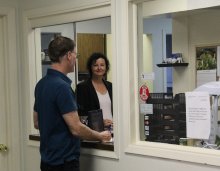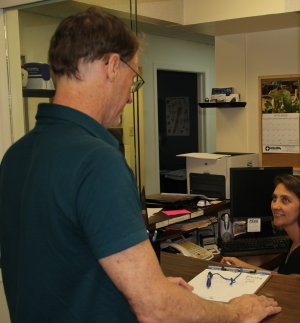Joint Pain and Arthritis
Arthritis literally means "inflammation of a joint." In a few forms of arthritis, including osteoarthritis, the irritation comes up because the smooth covering (articular cartilage) on the ends of bones get damaged or worn. Osteoarthritis is in most cases within one, customarily weightbearing, joint.
In other kinds of arthritis, such as rheumatoid arthritis, the joint lining becomes inflamed as part of a disease function that has an effect on the entire body. Some other forms of arthritis are: seronegative spondyloarthropathies, crytalline deposition diseases, and septic arthritis.
Arthritis is a major cause of lost work time and serious disability for lots of people in Central Missouri. Though arthritis is primarily a disease of adults, children may also have it.
Anatomy
Arthritis is a disease of the joint. A joint is where the ends of two or more bones meet. The knee-joint, for instance, is formed between the bones of the lower leg (the shinbone and the fibula) and the thighbone (the femur). The hip-joint is where the top of the thighbone (femoral head) meets a concave part of the pelvis (the acetabulum).
A smooth tissue of cartilage covers the tips of bones in a joint. Cartilage pillows the bone and enables the joint to move easily without the friction that would accompany bone-on-bone contact. A joint is enclosed by a fibrous envelope, known as the synovium, which produces a fluid that also helps to reduce friction and wear in a joint. Ligaments hook up the bones and keep your joint stable. Muscles and tendons power the joint and allow it to move.
 Cause
Cause
There are 2 main categories of arthritis.
The first type is caused by damage on the articular cartilage material (osteoarthritis) through the natural aging process, through continuous use, or through trauma (post-traumatic arthritis).
The other form is caused by one of numerous inflammatory processes.
Regardless of whether the cause is from injury, normal wear and tear, or disease, the joint will become inflamed, causing swelling, pain and stiffness. It's usually temporary. Inflammation is just one of the body's natural reactions to injury or disease. In arthritic joints, however, inflammation may lead to lasting or permanent disability.
Natural History
Osteoarthritis
The most prevalent type of arthritis for people in Mid-MO is osteoarthritis. It comes from overuse, trauma, or the deterioration of the joint cartilage that happens with age. Osteoarthritis is usually more painful in joints that carry weight, like the knee, hip, and spinal column, as opposed to in the wrist, elbow, and shoulder joints. However, joints that are used frequently in work or sports or joints which have been hurt from fractures or other injuries may show signs of osteoarthritis. Other disorders that injure or overburden the articular cartilage material can lead to osteoarthritis.
In osteoarthritis, the cartilage material covering the bone ends gradually wears away. Quite often, bone growths called "spurs" develop at the edges of osteoarthritic joints. The bone can become hard and firm (sclerosis). The joint gets inflamed, causing pain and swelling. Continuing use of the joint is painful.
Rheumatoid Arthritis
Rheumatoid arthritis is a long-lasting disease. It's estimated that 1% of the populace all over the world have rheumatoid arthritis. Ladies are three times more likely than males to have rheumatoid arthritis. The development of rheumatoid arthritis slows down with age.
Rheumatoid arthritis impacts numerous areas of the body, but chiefly the joints. The human body's immune system, which generally protects the body, actually starts to make substances that assault the body. In rheumatoid arthritis, the joint lining grows, invading neighboring tissues. Chemical substances are made that attack and demolish the joint surface.
Rheumatoid arthritis may affect both large and small joints in the body and also the spine. Swelling, pain, and stiffness commonly develop, even whenever the joint isn't utilized. In many circumstances, juvenile arthritis might cause similar symptoms in children.
 Diagnosis
Diagnosis
Arthritis is identified through a careful assessment of symptoms and a physical examination. X-rays are essential to show the extent of any damage to the joint. Blood tests and other laboratory tests may help to determine the type of arthritis. Some of the findings of arthritis include:
• Weakness (atrophy) in the muscles
• Tenderness to touch
• Restricted capacity to move the joint passively (with help) and actively (without assistance).
• Signs that other joints are painful or inflamed (an indication of rheumatoid arthritis)
• A grating feeling or sound (crepitus) with motion
• Pain whenever pressure is placed on the joint or the joint is moved
Medications
Over the counter medicines can be utilized to manage pain and inflammation within the joints. These medicines, known as anti-inflammatory drugs, include aspirin, ibuprofen, and naproxen. Acetaminophen may be effective in regulating pain.
Prescription drugs are also available. A doctor will select a medicine by taking into consideration the type of arthritis, its seriousness, and the individual's basic physical health. Patients with ulcers, asthma, kidney, or liver disease, for instance, may not be able to correctly take anti-inflammatory medicines.
Shots of cortisone into the joint may temporarily help to alleviate pain and swelling. It is very important know that repeated, regular injections into the same joint can harm it, causing undesirable side effects.
Viscosupplementation or injections of hyaluronic acid preparations can also be effective in lubricating the joint. This is normally perfomed in the knee.
Exercise and Therapy
Canes, crutches, walkers, or splints can help relieve the stress and strain on arthritic joints. Understanding methods of doing day to day activities that are the less stressful to painful joints also may be of assistance.
Particular exercises and physical therapy can be utilized to diminish stiffness and to bolster the weakened muscle tissue around the joint.
Surgery
In general, an orthopaedic surgeon will do surgery for arthritis once other types of nonsurgical treatment have failed to alleviate pain and other symptoms. When selecting the type of surgery, the physician and patient will take into account the form of arthritis, its severity, and the patient's physical condition.
There are a number of surgical operations. These include:
• Taking out the diseased or damaged joint lining
• Realignment of the joints
• Fusing the ends of the bones within the joint with each other, to prevent joint motion and reduce joint pain
• Replacing the entire joint (total joint replacement)
Long-Term Management
In most cases, persons with arthritis can continue to carry out regular activities of daily living. Exercise programs, anti-inflammatory drugs, and weight reduction for obese persons are frequent steps to minimize pain, stiffness, and improve function.
In persons with severe cases of arthritis, orthopaedic surgery can often supply dramatic pain relief and regain lost joint function.
Some forms of arthritis, such as rheumatoid arthritis, are usually addressed by a group of health care professionals like that from Audrain Orthopaedics in Mexico, MO. These experts may include rheumatologists, physical and occupational therapists, social workers, therapy specialists, and orthopaedic surgeons.
Research
Presently, most kinds of arthritis can't be cured. Scientists keep on making advancements in locating the root factors for the key types of arthritis. Meanwhile, orthopaedic surgeons, cooperating with other medical professionals and scientists, have created many effective treatments for arthritis. If you live in Mexico, Columbia, Jefferson City, Boonville, or Moberly, MO and want to find out more about these treatments, get a hold of Audrain Orthopaedics today and schedule an appointment.

